Utah honeysuckle facts for kids
Quick facts for kids Utah honeysuckle |
|
|---|---|
 |
|
| Conservation status | |
| Scientific classification | |
| Genus: |
Lonicera
|
| Species: |
utahensis
|
The Utah honeysuckle (scientific name: Lonicera utahensis) is a beautiful flowering plant. It belongs to the honeysuckle family. People also call it red twinberry or fly honeysuckle. This plant grows naturally in western North America. You can find it from British Columbia down to Arizona. It also grows from Washington (state) and Oregon east to Alberta and Montana. It loves the Rocky Mountains!
Contents
Meet the Utah Honeysuckle
The Utah honeysuckle is a type of honeysuckle plant. It is a deciduous shrub, which means it loses its leaves every fall. This plant can grow to be about 1 to 2 meters (3 to 6 feet) tall. It often has thin branches that spread out. Sometimes, it grows in a clumpy shape.
What Does It Look Like?
The leaves of the Utah honeysuckle are oval or oblong. They can be up to 8 centimeters (about 3 inches) long and 4 centimeters (about 1.5 inches) wide. The underside of the leaves can be smooth or have stiff hairs.
The plant produces pairs of flowers. These flowers grow on stalks called peduncles. These stalks can be up to 15 centimeters (about 6 inches) long. The flowers themselves are yellow or yellowish-white. They are usually 1 to 2 centimeters (less than an inch) long.
After the flowers, the plant grows bright red berries. Each berry is almost 1 centimeter (about 0.4 inches) wide. These berries are important for animals.
How Does It Reproduce?
The Utah honeysuckle spreads its seeds with the help of animals. Birds and bears love to eat the red berries. When they eat the fruit, they help carry the seeds to new places. This is called seed dispersal. It helps new honeysuckle plants grow in different areas.
Where Does It Grow?
This plant often grows in the understory of old forests. The understory is the layer of plants that grows beneath the main tree canopy. You might find it under trees like grand fir and Rocky Mountain maple.
The Utah honeysuckle is often a "climax species." This means it is a plant that grows well in a stable, mature forest. It can also be a main plant in certain areas. For example, it might grow alongside common beargrass in subalpine fir forests.
You can find this plant at many different heights. It grows from 300 meters (about 1,000 feet) up to 3,400 meters (about 11,000 feet) high. However, it is most common between 1,200 and 2,400 meters (about 4,000 to 8,000 feet).
Many other plants grow near the Utah honeysuckle. These include white spiraea, ninebark, Scouler willow, and Sitka alder. You might also see thinleaf huckleberry, pinegrass, queencup beadlily, and sweetscented bedstraw.
How People Use It
The Utah honeysuckle is a pretty plant. Because of its beauty, people sometimes use it as an ornamental plant. This means they plant it in gardens or parks for decoration. It can also be used in revegetation projects. These projects help bring plants back to areas where they have been removed or damaged.


